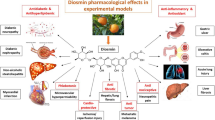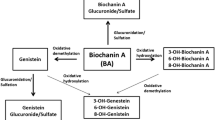Abstract
This study aims to improve the drug oral bioavailability by co-administration with flavonoid inhibitors of the CYP2C isozyme and to establish qualitative and quantitative (QSAR) structure–activity relationships (SAR) between flavonoids and CYP2C. A total of 40 naturally occurring flavonoids were screened in vitro for CYP2C inhibition. Enzyme activity was determined by measuring conversion of tolbutamide to 4-hydroxytolbutamide by rat liver microsomes. The percent inhibition and IC50 of each flavonoid were calculated and used to develop SAR and QSAR. The most effective flavonoid was orally co-administered in vivo with a cholesterol-reducing drug, fluvastatin, which is normally metabolized by CYP2C. The most potent CYP2C inhibitor identified in vitro was tamarixetin (IC50 = 1.4 μM). This flavonoid enhanced the oral bioavailability of fluvastatin in vivo, producing a >2-fold increase in the area under the concentration–time curve and in the peak plasma concentration. SAR analysis indicated that the presence of a 2,3-double bond in the C ring, hydroxylation at positions 5, 6, and 7, and glycosylation had important effects on flavonoid–CYP2C interactions. These findings should prove useful for predicting the inhibition of CYP2C activity by other untested flavonoid-like compounds. In the present study, tamarixetin significantly inhibited CYP2C activity in vitro and in vivo. Thus, the use of tamarixetin could improve the therapeutic efficacy of drugs with low bioavailability.




Similar content being viewed by others
REFERENCES
Wu CY, Benet LZ. Predicting drug disposition via application of BCS: transport/absorption/elimination interplay and development of a biopharmaceutics drug disposition classification system. Pharm Res. 2005;22:11–23.
Zhou S, Gao Y, Jiang W, Huang M, Xu A, Paxton JW. Interactions of herbs with cytochrome P450. Drug Metab Rev. 2003;35:35–98.
Foster BC, Arnason JT, Briggs CJ. Natural health products and drug disposition. Annu Rev Pharmacol Toxicol. 2005;45:203–26.
Zhou S, Koh HL, Gao Y, Gong ZY, Lee EJD. Herbal bioactivation: the good, the bad and the ugly. Life Sci. 2004;74:935–68.
Boumendjel A, Pietro AD, Dumontet C, Barron D. Recent advances in the discovery of flavonoids and analogs with high-affinity binding to P-glycoprotein responsible for cancer cell multidrug resistance. Med Res Rev. 2002;22:512–29.
Cermak R, Wolffram S. The potential of flavonoids to influence drug metabolism and pharmacokinetics by local gastrointestinal mechanisms. Curr Drug Metab. 2006;7:729–44.
Cermak R. Effect of dietary flavonoids on pathways involved in drug metabolism. Expert Opin Drug Metab Toxicol. 2008;4:17–35.
Mullie P, Clarys P, Deriemaeker P, Hebbelinck M. Estimation of daily human intake of food flavonoids. Int J Food Sci Nutr. 2008;59:291–8.
Scalbert A, Williamson G. Dietary intake and bioavailability of polyphenols. J Nutr. 2000;130(Suppl):2073–85.
Moon YJ, Wang X, Morris ME. Dietary flavonoids: effects on xenobiotic and carcinogen metabolism. Toxicol in Vitro. 2006;20:187–210.
Krishna D, Klotz U. Extrahepatic metabolism of drugs in humans. Clin Pharmacokinet. 1994;26:144–60.
Rendic S, di Carlo FJ. Human cytochrome P450s enzymes: a status report summarizing their reactions, substances, inducers, and inhibitors. Drug Metab Rev. 2001;29:413–580.
Shimada T, Yamazaki H, Mimura M, Inui Y, Guengerich FP. Interindividual variations in human liver cytochrome P450s enzymes involved in the oxidation of drugs, carcinogens and toxic chemical: studies with liver microsomes of 30 Japanese and 30 Caucasians. J Pharmacol Exp Ther. 1994;270:414–23.
Goldstein JA. Clinical relevance of genetic polymorphisms in the human CYP2C subfamily. Brit J Clin Pharmacol. 2001;52:349–55.
Lee CR, Pieper JA, Frye RF, Hinderliter AL, Blaisdell JA, Goldstein JA. Tolbutamide, flurbiprofen, and losartan as probes of CYP2C9 activity in humans. J Clin Pharmacol. 2003;43:84–91.
**e HG, Prasad HC, Kim RB, Stein CM. CYP2C9 allelic variants: ethnic distribution and functional significance. Adv Drug Deliv Rev. 2002;54:1257–70.
Kruijtzer CMF, Beijnen JH, Schellens JHM. Improvement of oral drug treatment by temporary inhibition of drug transporters and/or cytochrome P450 in the gastrointestinal tract and liver: an overview. Oncologist. 2002;7:516–30.
Ding X, Kaminsky LS. Human extrahepatic cytochromes P450: function in xenobiotic metabolism and tissue-selective chemical toxicity in the respiratory and gastrointestinal tracts. Annu Rev Pharmacol Toxicol. 2003;43:149–73.
Williamson G, Manach C. Bioavailability and bioefficacy of polyphenols in human. II. Review of 93 intervention studies. Am J Clin Nutr. 2005;81 Suppl 1:243–55.
Kim JY, Lee S, Kim DH, Kim BR, Park R, Lee BM. Effects of flavonoids isolated from Scutellariae radix on cytochrome P-450 activities in human liver microsomes. J Toxicol Environ Health A. 2002;65:373–81.
Quintieri L, Bortolozzo S, Straliotto S, Moro S, Pavanetto M, Nassi A, et al. Flavonoids diosmetin and hesperetin are potent inhibitors of cytochrome P450 2C9-mediated drug metabolism in vitro. Drug Metab Pharmacokinet. 2010;25:466–76.
Kimura Y, Ito H, Ohnishi R, Hatano T. Inhibitory effects of polyphenols on human cytochrome P450 3A4 and 2C9 activity. Food Chem Toxicol. 2010;48:429–35.
Yuan R, Madani S, Wei XX, Reynolds K, Huang SM. Evaluation of cytochrome P450s probe substrates commonly used by the pharmaceutical industry to study in vitro drug interaction. Drug Metab Dispos. 2002;30:1311–9.
Toda T, Eliasson E, Ask B, Inotsume N, Rane A. Roles of different CYP enzymes in the formation of specific fluvastatin metabolites by human liver microsomes. Basic Clin Pharmacol Toxicol. 2009;105:327–32.
Scripture CD, Pieper JA. Clinical pharmacokinetics of fluvastatin. Clin Pharmacokinet. 2001;40:263–81.
Sheu MT, Liou YB, Kao YH, Lin YK, Ho HO. A quantitative structure–activity relationship for the modulation effects of flavonoids on P-glycoprotein-mediated transport. Chem Pharm Bull. 2010;58:1187–94.
Pao LH, Hu OYP, Fan HY, Lin CC, Liu LC, Huang PW. Herb–drug interaction of 50 Chinese herbal medicines on CYP3A4 activity in vitro and in vivo. Am J Chin Med. 2012;40:57–73.
Lowry OH, Rosebrough NJ, Farr AL, Randall RJ. Protein measurement with the folin phenol reagent. J Biol Chem. 1951;193:265–75.
Miners JO, Smith KJ, Robson RA, McManus ME, Veronese ME, Birkett DJ. Tolbutamide hydroxylation by human liver microsomes: kinetic characterisation and relationship to other cytochrome P450 dependent xenobiotic oxidations. Biochem Pharmacol. 1988;37:1137–44.
Eagling VA, Tjia JF, Back DJ. Differential selectivity of cytochrome P450 inhibitors against probe substrates in human and rat liver microsomes. Br J Clin Pharmacol. 1998;45:107–14.
Toreson H, Eriksson BM. Determination of fluvastatin enantiomers and the racemate in human blood plasma by liquid chromatography and fluorometric detection. J Chromatogr A. 1996;729:13–8.
Kitagawa S. Inhibitory effects of polyphenols on P-glycoprotein-mediated transporter. Biol Pharm Bull. 2006;29:1–6.
Shimada T, Tanaka K, Takenaka S, Murayama N, Martin MV, Foroozesh MK, et al. Structure–function relationships of inhibition of human cytochromes P450 1A1, 1A2, 1B1, 2C9, and 3A4 by 33 flavonoid derivatives. Chem Res Toxicol. 2010;23:1921–35.
Lorenz M, Wessler S, Follmann E, Michaelis W, Dusterhoft T, Baumann G, et al. A constituent of green tea, epigallocatechin-3-gallate, activates endothelial nitric oxide synthase by a phosphatidylinositol-3-OH-kinase-, cAMP-dependent protein kinase-, and Akt-dependent pathway and leads to endothelial-dependent vasorelaxation. J Biol Chem. 2004;279:6190–5.
Sherry Chow HH, Hakim I, Vining D, Crowell J, Cordova C, Chew W, et al. Effects of repeated green tea catechin administration on human cytochrome P450 activity. Cancer Epidemiol Biomarkers Prev. 2006;15:2473–6.
Nielsen SE, Breinholt V, Justesen U, Cornett C, Dragsted LO. In vitro biotransformation of flavonoids by rat liver microsomes. Xenobiotica. 1998;29:389–401.
Breinholt VM, Offord EA, Brouwer C, Nielsen SE, Brosen K, Friedberg T. In vitro investigation of cytochrome P450s-mediated metabolism of dietary flavonoids. Food Chem Toxicol. 2002;40:609–16.
Wright B, Moraes LA, Kemp CF, Mullen W, Crozier A, Lovegrove JA, et al. A structure basis for the inhibition of collagen-stimulated platelet function by quercetin and structurally related flavonoids. Br J Pharm. 2010;159:1312–25.
Walle T. Absorption and metabolism of flavonoids. Free Radic Biol Med. 2004;36:829–37.
Lan K, Jiang XH, He JL. Quantitative determination of isorhamnetin, quercetin and kaempferol in rat plasma by liquid chromatography with electrospray ionization tandem mass spectrometry and its application to the pharmacokinetic study of isorhamnetin. Rapid Commun Mass Spectrom. 2007;21:112–20.
Si D, Wang Y, Zhou YH, Guo Y, Wang J, Zhou H, et al. Mechanism of CYP2C9 inhibition by flavones and flavonols. Drug Metab Dispos. 2008;37:629–34.
Dohadwala MM, Holbrook M, Hamburg NM, Shenouda SM, Chung WB, Titas M, et al. Effects of cranberry juice consumption on vascular function in patients with coronary artery disease. Am J Clin Nutr. 2011;93:934–40.
Rizza S, Muniyappa R, Iantorno M, Kim JA, Chen H, Pullikotil P, et al. Citrus polyphenol hesperidin stimulates production of nitric oxide in endothelial cells while improving endothelial function and reducing inflammatory markers in patients with metabolic syndrome. J Clin Endocrinol Metab. 2011;96:E782–92.
Gates MA, Tworoger SS, Hecht JL, De Vivo I, Rosner B, Hankinson SE. A prospective study of dietary flavonoids intake and incidence of epithelial ovarian cancer. Int J Cancer. 2007;121:2225–32.
Egert S, Rimbach G. Which sources of flavonoids: complex diets or dietary supplements? Adv Nutr. 2011;2:8–14.
Amini-Shirazi N, Ghahremani MH, Ahmadkhaniha R, Mandegary A, Dadgar A, Abdollahi M, et al. Influence of CYP2C9 polymorphism on metabolism of valproate and its hepatotoxin metabolite in Iranian patients. Toxicol Mech Method. 2010;20:452–7.
Pan-Zhou XR, Cretton-Scott E, Zhou XJ, Yang MX, Lasker JM, Sommadossi JP. Role of human liver P450s and cytochrome b5 in the reductive metabolism of 3′-azido-3′-deoxythymidine (AZT) to 3′-amino-3′-deoxythymidine. Biochem Pharmacol. 1998;55:757–66.
ACKNOWLEDGMENTS
This work was supported in part by Taiwan Biotech Co., Ltd. and Novartis Co., Ltd. in Taiwan. We are grateful to Dr. Ueng Yune-Fang for her technical assistance.
Statement of interest
No conflict of interest to be declared by authors.
Financial Support
No
Author information
Authors and Affiliations
Corresponding author
Rights and permissions
About this article
Cite this article
Wang, HJ., Pao, LH., Hsiong, CH. et al. Dietary Flavonoids Modulate CYP2C to Improve Drug Oral Bioavailability and Their Qualitative/Quantitative Structure–Activity Relationship. AAPS J 16, 258–268 (2014). https://doi.org/10.1208/s12248-013-9549-4
Received:
Accepted:
Published:
Issue Date:
DOI: https://doi.org/10.1208/s12248-013-9549-4




